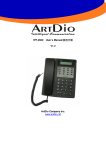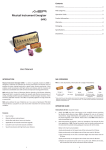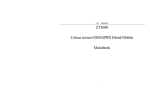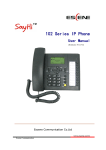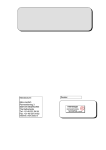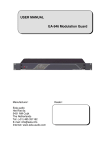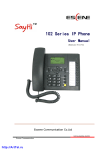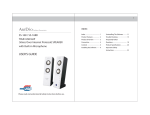Download ArtDio IPF-3000 Installation guide
Transcript
IPF-3000 Quick Installation Guide V1.1 ARTDio Company Inc. www.artdio.com.tw Quick Installation Guide -i- IPF-3000 Quick Installation Guide <English Version> Please link to http://www.artdio.com.tw to download detailed manuals, including “IP SIP Phone User’s Guide” and “IP SIP Phone Management”. CONTENTS I. IP-3000 Diagram .......................................................................................................................... 1 1. Front View .................................................................................................................................. 1 2. Rear View ................................................................................................................................... 1 3. Back View ................................................................................................................................... 1 II. Key Definition........................................................................................................................... 2 III. Basic Configuration ................................................................................................................. 4 1. How to activate 『Main Menu』?............................................................................................ 4 2. Network Settings ........................................................................................................................ 4 (1) DHCP ............................................................................................................................. 4 (2) Static IP Environment(Fixed IP)............................................................................... 4 (3) 3. IV. PPPoE ............................................................................................................................ 4 SIP Service ................................................................................................................................. 5 Phone Calls ............................................................................................................................... 6 1. How to dial out?....................................................................................................................... 6 2. Dialing Method .......................................................................................................................... 7 (1) Address book.................................................................................................................. 7 (2) Call History .................................................................................................................... 7 (3) ENUM Dialing............................................................................................................... 7 (4) Intra-Domain Dialing..................................................................................................... 7 (5) Contact Dialing .............................................................................................................. 7 (6) IP Dialing ....................................................................................................................... 7 (7) LAN Dialing .................................................................................................................. 8 3. Add, Search, Delete and Modify Address Book.......................................................................... 8 (1) Add new address ............................................................................................................ 8 (2) Search............................................................................................................................. 8 (3) Delete ............................................................................................................................. 8 Quick Installation Guide -ii- IPF-3000 (4) Modify............................................................................................................................ 8 4. Speed Dial .................................................................................................................................. 9 (1) Add speed dial number .................................................................................................. 9 (2) Remove a specific speed dial entry................................................................................ 9 (3) Speed Dial ...................................................................................................................... 9 5. How to activate and deactivate call screen?.............................................................................. 9 6. List all screened Numbers.......................................................................................................... 9 V. Call Forward ................................................................................................................................ 9 1. Set up forwarding number.......................................................................................................... 9 2. Enable Call Forwarding Features ........................................................................................... 10 (1) All Calls Forward (Unconditionally Forward)............................................................. 10 (2) Busy Forward............................................................................................................... 10 (3) No Answer Forward ..................................................................................................... 10 3. Do Not Disturb (DND).............................................................................................................. 11 VI. Phone Settings ........................................................................................................................ 12 1. Password .................................................................................................................................. 12 2. DSS features ............................................................................................................................. 12 3. Date/Time ................................................................................................................................. 13 4. Ringer....................................................................................................................................... 13 5. Lock.......................................................................................................................................... 13 VII. NAT and Firewall ................................................................................................................... 14 1. To determine whether you resides on public internet or local area network........................... 14 2. Public Internet Configuration.................................................................................................. 14 3. LAN Configuration to Traverse NAT/Firewall......................................................................... 14 4. Option-1: Contact your network administrator to configure your NAT/Firewall route. ......... 14 5. Option-2 Activate STUN .......................................................................................................... 16 (1) To determine whether you are currently NATed or behind a firewall.......................... 16 (2) Activate STUN Mode .................................................................................................. 16 VIII. IX. Specify CODEC.................................................................................................................. 16 Advanced Call Processing ..................................................................................................... 17 Quick Installation Guide -iii- IPF-3000 1. Mute ......................................................................................................................................... 17 2. Hold and Retrieve .................................................................................................................... 17 3. Handset, Speaker-phone, Ear-phone and Loud-speaker (Open-listening).............................. 17 4. Transfer .................................................................................................................................... 18 (1) Consultative transfer ........................................................................................................ 18 (2) Blind Transfer .................................................................................................................. 18 5. Conference ............................................................................................................................... 19 (1) When you have set up two connected calls...................................................................... 19 (2) When you have only one connected call.......................................................................... 19 Quick Installation Guide -iv- IPF-3000 I. IPF-3000 Diagram 1. Front View 2x16 LCD Speaker Keypad Handset Microphone 2. Rear View Power jack 10/100 RJ-45 Ethernet Port (to PC) Reset 10/100 RJ-45 Ethernet Port (to LAN) 3. Back View Ear-phone Jack (RJ-11) Wall Mount Handset Jack (RJ-11) Quick Installation Guide -1- IPF-3000 II. Key Definition Service Realm A/B Channel Reject MWI MUTE FUNC FLASH SPK/Hands-free HOLD XFER REDIAL Volume【−,+】 SPD 【Name】 :Functions in Call Mode | Functions in Menu Mode 【A/B Channel】:Call lines (2 concurrent calls at most) / Review the calling information on this channel during conversation. 【Service Realm】:Display the registration status of each active service domain on idle; switch target service domain (ISP) while making calls. 【Reject】:Reject incoming waiting calls 【MWI】:Message Waiting Indication, MWI: Access to voice mail system. 【MUTE】: Mute | Delete character 【FUNC】:Menu | Return to upper level submenu 【SPK】:Hands-free | Exit menu 【HOLD】:Hold | Confirm, Save 【SPD】:Speed Dial 【REDIAL】:Redial the last dialed number. 【Flash】:Take back transferring calls/Exit Conference mode 【XFER】:Transfer 【+】:Volume UP (Ringer, headset, handset, speaker) | Next item、Move cursor to right 【-】:Volume Down (Ringer, headset, handset, speaker) | Previous item、Move cursor to left Quick Installation Guide -2- IPF-3000 【Registration】:Re-register. The LED indicates the registration status of each active service domain: Green LED On: Successfully register to all active service domains. Red LED On: At least one service domain could not be registered. Green LED Flashes: Registration is in progress. Red LED Flashes: No service domains have ever registered successfully. 【Auto-redial】:Auto-redial the last dialed number ‘till connected (ringing). This feature can be activated when busy tone is heard or as a shorthand of 【Redial】+ 【Auto-redial】. Once activated, the corresponding LED will be on. 【DND】:Do Not Disturb (red LED indicates on) 【Forward】:Forward incoming waiting calls 【URL】:Use keypad to enter alphabets and numbers (red LED on). 【Address Book】:Access to address book (search an entry or list all entries). 【Call History】 :Missed calls/Received calls/Dialed Number. If the red LED is flashing, it indicates there are unread records of missed calls. 【Conference】:3-party local conferencing Registration URL Auto-redial Address Book DND Call History Forward Quick Installation Guide Conference -3- IPF-3000 III. Basic Configuration 1. How to activate 『Main Menu』? 1.Press 【FUNC】+ 【#】。 2.Telnet into the phone on TCP port 23. The login password is same as phone lock password, which default is “0000”. 3.Initially, your phone can only be configured via keypad since it bears no valid IP yet. After finishing configuring your network, you could use telnet client to configure your phone on TCP port 23. 2. Network Settings Please go to 『Main Menu』 =>【6.Network】/【1.General】to configure your phone based on your network environment: DHCP, static IP or PPPoE. (1) DHCP z Pick【1.Mode】/【1.DHCP】 z Disable【4.Use static DNS】by choosing 【2.DHCP/PPPoE】 1. If you want to assign a different domain name server instead of using those obtained by DHCP or PPPoE, you should choose【1.static DNS】and set the IP of your specific DNS into 【6.Network】/【1.General】/【5.Static DNS】, such as “1.Primary DNS” = 192.168.3.254* (2) Static IP Environment(Fixed IP) z Pick【1.Mode】/【2.Static assign】 z Go to【2.Static settings】, and enter your network configurations based on your ISP. For example: 1. Host IP = 211.75.40.2* 2. Network mask = 255.255.255.240* z 3. Gateway IP = 211.75.40.1* Enable【4.Use static DNS】by choosing 【1.static DNS】 z Assign【5.Static DNS】, such as: “1.Primary DNS = 168.95.1.1*” (3) PPPoE z Pick【1.Mode】/【1.DHCP】 z Go to【3.PPPoE settings】and enter your PPPoE authentication information, such as: 1. z Login ID = MyPPPoEAccount* 2. Password = PPPoEDialupPassword* Disable【4.Use static DNS】by choosing 【2.DHCP/PPPoE】 i. If you want to assign a different domain name server instead of using those obtained Quick Installation Guide -4- IPF-3000 by DHCP or PPPoE, you should choose【1.static DNS】and set the IP of your specific DNS into【5.Static DNS】, such as “1.Primary DNS” = 192.168.3.254* 【*】Value should be adjusted to your real network environment Note: if you reside on a LAN without gateway, you should specify the gateway IP as “0.0.0.0” rather than assigning a non-existent or an invalid IP. 3. SIP Service (1) (2) Let’s assume that you have obtained the following information from your SIP ISP: z Account: Michael z Password: secret z SIP AoR: [email protected] z SIP Proxy/Registrar Server: sip.isp.com, which serves on UDP port 5060 『Main Menu』=>『6.Network』/『2.SIP settings』/『2.Service domain』/『1.1st Realm』 z Activation: Enabled z Authentication: Note: please remember to check for ending blanks and spaces; if you erroneously input the ending spaces, the whole string (including ending spaces) will be treated as your password without trim). z z z 1. Server login: Michael 2. Server passwd: secret Address of record: 1. Display Name: Michael Jr. (Could be any combination of alphabets and numbers) 2. Protocol: sip 3. Sip:[email protected] Proxy server: 1. Configuration: 2.Use default 2. Default proxy: 1. Proxy FQDN: sip.isp.com 2. 3. Transport: 1.UDP (or 3.TCP and UDP) UDP port: 5060 (SIP proxy listening UDP port of your ISP.) 4. TCP port: 5060 (leave default intact) Registrar 1. Configuration: 1.Same as proxy 2. Registrar svr: leave default intact since the registrar and proxy server provided by your ISP are the same (3) If you have applied for more than one service domains, please repeat step (1) and (2) until all active domains are properly configured. IPF-3000 supports three different active service domains at most. Quick Installation Guide -5- IPF-3000 (4) Press 【SPK】 to exit the configuration menu and the system will try to register to those activated SIP domains. The flashing green LED of 【Registration】key indicates that the registration is undergoing. Once the green LED stops flashing, you could know the registration result by the LED: Green LED On: Successfully register to all active service domains. Red LED On: At least one service domain could not be registered. Green LED Flashes: Registration is in progress. Red LED Flashes: No service domains have ever registered successfully. Or press【Service Realm】to show registration status of each active service domain: 0 : a - v o i z ee . c o m 0 : f wd . p u l v e r . c o m X: u n k n o wn . c o m 0: Registered domain X: Registration failed domain (Retry after 90 seconds). IV. Phone Calls Press【SPK】to switch between hands-free and handset mode. However, if you switch to hands-free mode with handset lifted (off-hooked), the phone will be in loud-speaker mode: it continues transmitting voice from handset, not from microphone, and played voice to both speaker and handset receiver simultaneously. It will help clarify the voice of talker while letting all persons in the same room listen. The phone will activate microphone for voice transmission only when it is on hands-free mode and the handset is on hook. This applies to ear-phone mode as well. In loud speaker mode with ear-phone enabled, the ear-phone could hear voice but not speak-able. 1. How to dial out? a-voize.com f wd . p u l v e r . c o m fwd.pulver.com 3200 Auto-locate By default, you can gain access to active Service-Domain-N by line-N whenever applicable. That is, the default service domain of [B call] is 2nd active service domain if available; otherwise, it will use the 1st active service domain as default. Moreover, you could change the target service domain while making calls by pressing 【Service Realm】to circle those active service domains (no matter whether they have registered or not), but must before dialing the ‘#’, which finishes the dialing. The active service domain will appear on the upper-right corner. Quick Installation Guide -6- IPF-3000 2. Dialing Method In dialing phase, you could use【MUTE】to correct typos. (1) Address book z 『Main Menu』 =>『1.Address book』 『1.Search』 / (By default 【F4】 is programmed z to access address book). Pick the target number and press【REDIAL】to dial out. (2) Call History z Press【Call History】to choose desired call lists:Missed/Received/Dailed numbers. z z Traverse the list and pick up the target entry. Press 【REDIAL】to dial out. Note: if you press 【Call History】 while its red LED is flashing (indicating there are unviewed missed calls), it will enter the “Missed calls” list directly. (3) ENUM Dialing z Starting with【#】for ENUM dialing z Dial the target number (6 digits at least), ending with a【#】to speed up dialing phase. E.g.: to call “tel:+886-3-5295000”, please dial “#88635295000#”。 (4) Intra-Domain Dialing z z Enter the user part of the target AoR or dial alias number directly. The target SIP service domain could be circle by press 【Service Domain】. z Press 【#】to finishing dialing. Intra-domain dialing is applicable if both party registered to the same SIP domain (possibly to the same SIP proxy/registrar server) 。 E.g., if sip:[email protected] sip:[email protected], he wants to place a call to could just dial 【 3200 # 】 when “QuantierTech.com” has selected as target service domain. (5) Contact Dialing z Use 【*】for 『@』 and『.』 z z Use 【**】 for 『:』if the target SIP agent does not listen on UDP port 5060. Press【#】to finishing dialing E.g. 1: to call sip:[email protected], please dial “3200*192*168*10*200”. E.g. 2: to call sip:[email protected]:5070, please dial ”3200*192*168*10*200**5070”. (6) IP Dialing z Use【*】for 『@』 and『.』 z z Use【**】for “:” if the target SIP agent does not listen on UDP port 5060. Dial【#】to finish dialing. Quick Installation Guide -7- IPF-3000 E.g. 1: to call sip:192.168.10.200, please dial “192*168*10*200”. E.g. 2: to call sip:192.168.10.200:5070, please dial ”192*168*10*200**5070”. (7) LAN Dialing (Applicable only while both parties locate on the same LAN and their IP prefix, 24-bits, are the same). z Starts with a【*】 z Dial the last suffix of target IP (the number must be between 1 and 255, inclusive). z Use 【**】for “:” if the target SIP agent does not listen on UDP port 5060. E.g., if “192.168.10.200” wants to dial “192.168.10.31”, please dial 【*31#】 or 【*031#】。 ※ Note: 【*69】has been reserved for call return feature, please dial 【*069】 if you want to call a IP of “xxx.xxx.xxx.69”. 3. Add, Search, Delete and Modify Address Book (1) Add new address z 『Main Menu』=>『1.Address book』/『2.Add entry』 z Enter Display Nam, such as Michael z Pick address type, default is SIP. z Enter SIP AoR or ENUM number without protocol field, such as: i. sip: 211.75.40.2 ii. sip: [email protected] iii. tel: +886-3-5295000 (2) Search z 『Main Menu』=>『1.Address book』/『1.Search』 z Enter the prefix to search or press 【Hold】to list all addresses (3) Delete Option 1: z 『Main Menu』=>『1.Address book』/『1.Search』 z Search for the address to remove and press【HOLD】to view the item. z Pick『2.Erase』from this address and press【HOLD】to delete it. Option 2: z 『Main Menu』=>『1.Address book』/【3.Erase】 z Choose either 『1.One by one』or『2.Erase all』to clear address book. (4) Modify z 『Main Menu』=>『1.Address book』/『1.Search』 z Search for the address you want to modify then press【HOLD】to view Quick Installation Guide -8- IPF-3000 z Choose 『1.Modify』 from the menu of this address and modify it 4. Speed Dial (1) Add speed dial number z 『Main Menu』=>『1.Address book』/『4.Speed Dials』 z Go to the digit you want to set for speed dial and press 【HOLD】 z Pick the target number from address book to associate with this speed dial digit. Press 【HOLD】to save. (2) Remove a specific speed dial entry z 『Main Menu』=>『1.Address book』\『4.Speed Dials』 z Go to the digit you want to set for speed dial. z Press 【MUTE】to remove the current speed dial mapping. (3) Speed Dial z [0-19] +【SPD】; e.g.: ‘1’+【SPD】or ‘01’ + 【SPD】 z 【SPD】+ [00-19]; e.g.:【SPD】+ ‘01’. Note: if you want to dial single digit only, such as 【SPD】+ 【1】, please press an additional 【#】to finish dialing; otherwise, it will wait for the second digit until inter-digit timeout, which default is 4 seconds. For example, 【SPD】+ 【1】+ 【#】. 5. 6. How to activate and deactivate call screen? z 『Main Menu』=>『1.Address book』/『1.Search』 z Locate the target address that you want to screen and press 【HOLD】to choose z Go to『3.Screen Call』and press【HOLD】 to toggle call screen. List all screened Numbers z 『Main Menu』=>『1.Address book』/『5.Call screening』 to view all screened addresses. z Locate the target address that you want to remove from screening list and press 【HOLD】to choose. z Pick 『3.Revoke』and press 【HOLD】to remove it from the screened list. V. Call Forward 1. Set up forwarding number z 『Main Menu』=>『4.Call forward』/『1. Target number』 Quick Installation Guide -9- IPF-3000 z Press 【HOLD】 to pick an entry from address book. Use 【Õ】and 【Ö】to view the current forwarding number. Press 【MUTE】to remove the current mapping of forward number. Note: on incoming calls arrival, both red LED of 【Reject】and【Forward】function keys will be on. If you press 【Reject】on which time, the incoming call will be rejected as busy and recorded as a received call, but it will not be forwarded in anyway. If you would like to transfer it to your configured forwarding number, you should press【Forward】. If you have not configured the forwarding number, the incoming call will be rejected as busy and recorded as a missed call. 2. Enable Call Forwarding Features (1) All Calls Forward (Unconditionally Forward) z 『Main Menu』=>『4.Call forward』 / 『1.All calls fwd』 z Pick『Enabled』and press【HOLD】 to save your setting. z Once this feature is enabled, the red LED of【Forward】function key will flash to remind you that all incoming calls will be silently forwarded to the forwarding number you previously configured (no ringing tone would ever be heard!). If you have not configured the forwarding number, the peer will be replied as ”480 Temporarily unavailable” and recorded as a missed call. (2) Busy Forward z 『Main Menu』=>『4.Call forward』/『3.Busy forward』 z Pick『Enabled』and press【HOLD】to save your setting. z Once this feature is enabled, the system will start to forward incoming calls to the forwarding number you previously configured when the system is busy (on which time you have already had 2 calls are waiting). If you have not configured such forwarding number, it will reply the peer as busy and recorded as a missed call. (3) No Answer Forward z 『Main Menu』=>『4.Call forward』 / 『4.No answer fwd』/ 『1.Status』 and pick 『Enabled』, press【HOLD】to save it. z 『Main Menu』=>『4.Call forward』 / 『4.No answer fwd』/ 『2.No answer time』, and configure the ringing expiration time before forwarding the incoming call (system default is ringing for 30 seconds) . Press【HOLD】 to save your setting. Quick Installation Guide -10- IPF-3000 z Once “forward on no-answer” feature is enabled, if you do not answer the incoming call before the timer expires, it will be forwarded to the forwarding number you previously configured. If you have not configured the forwarding number, the peer will be replied as “no answer” and recorded as a missed call. 3. Do Not Disturb (DND) z Press【DND】function key to toggle this feature: if the red LED is on, this feature is enabled; otherwise it is disabled. z When this feature is on, all incoming calls will be silently (no ringing tone will ever be heard) forwarded to the forwarding number you previously configured. If you have not configured the forwarding number, the peer will be replied as ”480 Temporarily unavailable” and recorded as a missed call. Quick Installation Guide -11- IPF-3000 VI. Phone Settings 『Main Menu』=>『3. Phone Setting』 1. Password (needed while Telneting into the phone and unlocking the phone) z Enter your old password then press【HOLD】(Default password is “0000”) 2. z Enter your new password then press【HOLD】(Accept only digits 0~9) z Re-type your new password to confirm, then press【HOLD】to finish. DSS features User programmable keys for easy access to various phone features. DSS Keys z Pick the function keys you want to program for short-cut key then press【HOLD】. For example, you may program some hot-lines for one-touch dial out. z Browse the available functions, press【HOLD】to confirm. The default mapping of these programmable function keys are: 【F1】:Forward menu – shortcut to activate forward menu. 【F2】: Channel info–show information of the last call on each call channel【A / B】. 【F3】: Call Detail - show detail records of the latest three connected and finished calls. 【F4】: Speed dials – activate speed dial list. 【F5】: Messaging – Access to out-of-dialog instant messaging. 【F6】: Network Speed - adjust the voice quality based on network link speed. 【F7】: Network Info - show the current active host IP, MAC address and DNS IP(s). 【F8】: Call Return - place a call to the last incoming call, either a missed or received one Quick Installation Guide -12- IPF-3000 3. Date/Time z Choose the item and press【HOLD】to configure: 1. Date: System date 2. Time: System time 3. Date format: date displaying format 4. Time zone (default is GMT+00:00) Use digits key【0】~【9】to switch between +/5. DST settings (day-light saving time, default is 0:00) Note: if you want to keep the date and time you manually set, you must disable SNTP synchronization from 7.3.1-SNTP Mode; otherwise, it will synchronize system time with assigned NTP server. 4. Ringer 1. Ringer volume: (Adjust the ringing volume on incoming calls arrival). z 【+】and【-】to increase or decrease ringing volume. 2. Ringer type: (Pick your favorite ringing tone) z 【+】 and【-】to listen your favorite ringing, press 【HOLD】to save your setting. z To enable “13. User-defined” ringing tone, you must first record it via handset. 3. Record ring: (Personalize user-defined ringing tone) z Pick up handset to prepare for ring recording. z Press 【HOLD】to start recording your own ringing tone. z On finish, press another【HOLD】to stop recording ringing tone. z You can review the newly recorded ringing tone or press “1.Save” to replace the originally “13.User-defined” ringer type. Press【FUNC】to re-record again. z You can record nearly 8 seconds customized ringing tone. 5. Lock z 『Main Menu』=>『3.Phone settings』/『8. Lock』 z 『1.=Y』to lock out the phone such that it could not make outbound calls (but still could take incoming calls, or『2.=N』to cancel this operation and press【HOLD】to confirm. After locking out the phone, to unlock it, you need the phone password. Quick Installation Guide -13- IPF-3000 VII. NAT and Firewall If this phone locates within a local area network and you want to place a call to public internet, you must configure your phone to traverse the NAT and firewall currently behind. 1. To determine whether you resides on public internet or local area network z 『Main Menu』=>『8.Advanced』/『4.System status』 or press 【F7】(default is “Network info”). z Go to 『1.Network』 and use【+】and【-】to navigate active network configuration: host IP, MAC address, active primary DNS IP and optional secondary DNS IP (In that order). z If your host IP is within any of the listed ranges, then your IPF-3000 resides on LAN, otherwise, it locates on public internet. i. 10.0.0.0 ~ 10.255.255.255 (10.xxx.xxx.xxx). ii. 172.16.0.0 ~ 172.31.255.255 (172.16.xxx.xxx ~ 172.31.xxx.xxx). iii. 192.168.0.0 ~ 192.168.255.255 (192.168.xxx.xxx). Note: if your host IP is 127.0.0.1, you should reconfigure your network to acquire a valid IP. 2. Public Internet Configuration z 『Main Menu』=>『6.Network』/『4.NAT & firewall』/『2.UDP traversal』 z 3. Enable “1.Full access” by press 【HOLD】 LAN Configuration to Traverse NAT/Firewall There are basically 2 options for CPE to traverse NAT/Firewall: (a) Option 1: Set up a static route in the NAT gateway (Recommend)。 (b) Option 2: Use STUN to measure out ports. Please adopt suitable option based on your network configuration. Note: some SIP ISPs may provide SIP-aware router (NAT/Firewall) for their customers. When you use a SIP-aware router, NAT detection should be set to "Off" as if you were on the public internet and the configuration is the same as “Public Internet Configuration”: 『6.Network』/『4.NAT & firewall』/『2.UDP traversal』/『1.Full access』, which is to say that you do not have to worry about the NAT, nor firewall. 4. Option-1: Contact your network administrator to configure your NAT/Firewall route. z Contact your network administrator and acquire at least 7 consecutive UDP ports mapped from the NAT to your IPF-3000. For example: i. NAT IP = 210.95.168.1 (you may detect your NAT IP by STUN from 『Main Menu』=>『6.Network』/『4.NAT & firewall』/ 『1. STUN』/ 『2. Diagnose NAT』) ii. The network administrator has mapped UDP port 10101~10107 from NAT to your IPF-3000 192.168.1.50. Quick Installation Guide -14- IPF-3000 Note 1: Since the network administrator has to configure the NAT/firewall to map those UDP ports to your IPF-3000, thus you should use static IP instead of DHCP as your network configuration. Otherwise you take the risk that the IPF-3000 would get a different IP from the currently set into the mapping when it reboot and re-get its IP by DHCP. Note 2: If there are several phones reside under the same NAT, their NAT port mappings must not be overlapped since they all share the same NAT resource! z Configure SIP service signaling port:『Main Menu』=>『6.Network』 『2.SIP / settings』 /『1.SIP service』. Take the scenario above as an example: 1. Transport: 1 (or 3, you must include UDP anyway). 2. SIP port: 10101 z Configure RTP ports by going to 『Main Menu』=>『6.Network』『 / 3 RTP settings』. Take the mapped ports as an example: 1. Base: 10102 (Must be an even number and between 3000 and 65532) 2. Range: 6 (Must be an even number and larger than or equal to 4). Note: RTP ports are used for voice media transmission. Those ports must be consecutive and start with an even number. Besides, at least 4 ports are needed for a phone equips with a capacity of two concurrent calls, where each channel needs 2 ports for RTP/RTCP. z Assign static NAT IP by going to『Main Menu』=>『6.Network』 『4.NAT / & firewall』 『3.Static / NAT IP』 and fill in the acquired NAT IP from network administrator, such as 210.95.168.1 mentioned above (you may also detect your NAT IP by STUN from 『Main Menu』=>『6.Network』/『4.NAT & firewall』/ 『1. STUN』/ 『2. Diagnose NAT』). Note: if your NAT equipped with no fixed IP, such as those NATs dial into WAN by PPPoE, then you must synchronize the NAT IP currently set into IPF-3000 whenever your NAT IP changed (Such as NAT re-dialup). By default, the system will auto-detect the NAT IP (if the STUN server configured into menu-6.4.1.1『STUN server』is viable) and notify you by sending an instant message whenever it determine a mismatch between the NAT you configured into menu 6.4.3-『Static NAT IP』and the one it auto-discovered by STUN protocol. Alternatively, you may go to『Main Menu』=>『6.Network』/『4.NAT & firewall』/『4.Dynamic NAT IP』and enable『2.Update by STUN』to auto-refresh the newly changed NAT IP into menu-6.4.3『Static NAT IP』 whenever it detects an inconsistency. z Enable Assigned static NAT IP by going to 『Main Menu』=>『6.Network』『 / 4.NAT & firewall』/『2.UDP traversal』, selecting『2.Static NAT map』and press【HOLD】 to confirm activation. Quick Installation Guide -15- IPF-3000 5. Option-2 Activate STUN Setting up the NAT router is impossible in many cases, and new equipment may be too expensive. For these environments, "Simple Traversal of UDP Through NATs" (STUN) has come to rescue. To enable STUN, you must acquire the IP of your served STUN server and diagnose your NAT to see if STUN is viable. (1) To determine whether you are currently NATed or behind a firewall z Go to 『Main Menu』=>『6.Network』/『4.NAT & firewall』/『1.STUN』 and configure your STUN server in “1.STUN server”, such as “A-voize.com” (IPF-3000 will try to locate the STUN server of “A-voize.com” domain via DNS SRV query (_stun._udp.A-voize.com) or “STUN.A-voize.com” (explicitly specify the STUN server). Press 【HOLD】to confirm. z Go to 『Main Menu』=>『6.Network』/『4.NAT & firewall』/『1.STUN』/ 『2. Diagnose NAT』to detect your NAT type. If the diagnosis is one of the following, you could consider enable STUN as a way to traverse NAT; otherwise you should adopt option-1. 1. Public internet (Neither NAT nor Firewall is involved)。 2. Symmetric UDP Firewall 3. Full cone NAT 4. Restricted cone NAT 5. Port restricted cone NAT (2) Activate STUN Mode z 『Main Menu』=>『6.Network』/『4.NAT & firewall』/『2.UDP traversal』 z Choose ”3.Enable STUN” and press 【HOLD】to confirm. Note: the STUN server configured into 『6.Network』/『4.NAT & firewall』/『1.STUN』 /『1.STUN server』must be functional and reachable for STUN to work. VIII. Specify CODEC The CODECs available on the phone includes G.711A (64kbps), G.711µ (64kbps), G.729A/G.729AB (8 kbps), G.723.1/G.723.1A (both 5.3 and 6.4 kbps). The default preference is to prioritize them based on their compressed voice quality: the higher quality it is, the higher priority it will be. That is, the default CODEC preference is G.711A, G.711µ, G.729A then G.723.1A (in that order). High quality comes in a price: it consumes more precious bandwidth. Take G.711µ for example, it takes as much as 64 kbps per call, as opposed to 5.3 kbps if G.723.1A is employed. Thus, if you have limited bandwidth for VoIP, you should consider prioritize those CODECs come with lower bit-rates such that it will use the most preferred CODEC on making/taking calls. Quick Installation Guide -16- IPF-3000 To set up personal CODEC preference: z 『Main Menu』=>『8.Advanced』/『1.CODEC』/『1.Preferences』 z Reorder the CODEC precedence: i. 0: Disable the selected CODEC ii. 1: Highest priority iii. 8: Lowest priority Note: if you disable all CODECs, it will auto-arrange the available CODECs and those come with lower bit-rates take precedence. Besides, you should just lower the priorities of G.711 in most circumstances rather than overly disabling them such that the phone could gracefully fall back to G.711A or G.711µ when the peer does not support those low bit-rate CODECs for voice compression. IX. Advanced Call Processing 1. Mute z z Set up a connected call. Press【MUTE】to toggle your voice transmission. On muting state, the red LED of 【MUTE】will be on, and you can hear still the peer’s voice; however they cannot hear you. 2. Hold and Retrieve z Set up a connected call. z Press 【HOLD】 to put the peer on hold and the corresponding green LED of 【A/B Channel】 will flash (on which time you can put the handset back to the seat while keeping the peer connected). z Press 【HOLD】 again to retrieve the call. Alternatively, you can press 【A/B Channel】 to retrieve the call as well. If the handset is on hook, you can retrieve the holding call by turn on speaker phone by pressing【SPK】 too. Note: if you are held by the peer, IPF-3000 will play music-on-hold. 3. Handset, Speaker-phone, Ear-phone and Loud-speaker (Open-listening) z Press 【SPK】 to switch between speaker-phone and handset. The red LED of 【SPK】 indicates speaker-phone is on or off.. z However, if you are in ear-phone mode, then press 【SPK】will switch between handset Quick Installation Guide -17- IPF-3000 and ear-phone. The flashing red LED of 【SPK】indicates it is now in ear-phone mode. z To switch to loud-speaker phone (open-listening), you should turn the speaker on while keeping handset lifted (off-hooked). Then you can continue talking by handset while all by-listeners in the same room could hear your conversation from the speaker. This is to facilitate the meeting where there are many listeners but there is only one talking at any time. 4. Transfer (1) Consultative transfer (Announce it first before actually transfer the call). z Set up a connected call to party-A z Press【XFER】to put A on hold and gain dial-tone. z Dial the target number of party-B and press 【#】 to finish dial. z Wait ‘till B picks up, announcing the call from A (consultation). z If B is unwilling to take this call, you may press【FLASH】to cancel the transfer operation and take back A. z Press【XFER】again (or you could just hang up the call to B) to transfer party-A to party-B. Note, you may do so even when B has not picked up the consultation call yet (such as it is in ringing back phase) to perform a call-transfer; and this is the so-called Semi-attended transfer. z (Optional) Alternatively, you may press 【Conference】to hold a 3-way conference with A and B instead of transferring A to B. Alternatively, you may do a consultative transfer as follows: z Take an incoming call from party-A on【A Channel】. z Get an empty channel by pressing 【B Channel】to perform a call switch (effectively put A on hold), then make an outbound call to party-B. z After talking to party-B, you decide to transfer A to B, press 【XFER】 on 【B Channel】 to perform a call-transfer. Note, you may do so even when B has not picked up the consultation call yet (such as it is in ringing back phase) to perform a call-transfer; and this is the so-called Semi-attended transfer. z However, if you decide to host a conference among party-A and party-B rather than transfer from call-A to call-B, you should press【Conference】to conference both parties in. (2) Blind Transfer (Transfer the call without asking the transferring target first.) Quick Installation Guide -18- IPF-3000 z Set up a connected call to party-A z Press【XFER】to put A on hold and gain dial-tone. z Dial the target number of party-B without an ending 【#】; instead, you SHOULD press 【XFER】 immediately to transfer party-A to party-B; alternatively, you MAY just hang up (on B-channel) as soon as finishing dialing B’s number without an ending【#】. z (Optional) During dialing phase, if you decide not to transfer but to take back party-A, press 【FLASH】 to abandon blind transfer and take back A (alternative, you may press 【A/B Channel】to cancel blind transfer and take back A as well). Note, if you press 【#】 to finish dialing, it behaves just the same as consultative transfer. Alternatively, you may do a blind transfer as follows: z Take an incoming call from party-A on【A Channel】. z Get an empty channel by pressing 【B Channel】to perform a call switch (effectively put A on hold), and gain dial tone. z Dial the target number of party-B without an ending 【#】; instead, you SHOULD press 【XFER】 immediately to transfer party-A to party-B; alternatively, you MAY just hang up (on B-channel) as soon as finishing dialing B’s number without an ending【#】. 5. Conference (1) When you have set up two connected calls z z Set up two connected calls Press 【Conference】when either call is activate to create a conference. z If the 【Conference】could be set up, its green LED will be on. (2) When you have only one connected call z Call the first party, and set up a connected calls z Press 【Conference】to switch to an empty line, on which time the system will play dial-tone, waiting for user’s dial, and the red LED will be on. z System will set up a 3-way local conference when the 2nd call connected; on which time, the green LED will be on. Note: z If a 3-way local conference cannot be hosted, the red LED of 【Conference】 will flash for a while. This may due to the fact that both connected parties demand a compressed voice CODEC, such as G.723.1 or G.729 (A/B), and thus a conference cannot be held between them since the compressed voice CODEC is shared between them. z Once the conference call initiator disconnects, the calls are terminated between all parties. z To disconnect a specific party in a three-way local conference, you may ask the party to Quick Installation Guide -19- IPF-3000 whom you want to disconnect to hang up first. Alternatively, you may press 【FLASH】 z to tear down the conference and separate them into 2 independent calls first, then disconnect each of them as your wish. To place a conference call on hold, press the 【HOLD】 key. The other parties can not talk among themselves. To avoid disrupting the other callers, consider muting the call instead. To mute the call, press the 【MUTE】 button. z Call waiting calls cannot be conferenced in; the conferencing node must establish both legs of the 3-Way conference. z You cannot perform transfer on conference calls. z The phone supports only 3-way local conference. To conference in additional callers, the last person called with an IPF-3000 can call an additional person, that new person can then call someone else, and so on. This is called “daisy-chaining. z Remind You In Order to meet EMI Stand, Please Clip the attached EMI Core on the line to LAN. Clip the EMI Core on the Line to LAN. z Warning Warning From FCC This device complies with Part 15 of the FCC Rules. Operation is subject to the following two conditions: (1) this device may not cause harmful interference, and (2) this device must accept any interference received, including interference that may cause undesired Quick Installation Guide -20- IPF-3000 Limited Warranty ArtDio guarantees that every IP-phone and Voice Gateway is free from physical defects in material and workmanship under normal user for one (1) year from the date of purchase. The warranty will not apply if the unit has been subject to accident, misuse, abuse, disassembly, alteration or operated contrary to the instructions contained in this User Manual. If the product proves defective during this warranty period, call ArtDio Technical Support in order to obtain a Return Authorization Number. Be sure to have your proof of purchase and a barcode from the product’s packaging on hand when calling. Return requests cannot be proceed without proof of purchase. When returning a product, mark the Return Authorization Number clearly on the outside of the shipping package and include a copy of your original proof of purchase. All customers shall be held responsible for shipping and handling charges of the defective unit. In no event shall ArtDio’s Liability exceed the price paid for the product from direct, indirect, special, incidental, or consequential damages resulting from the use of the product, its accompanying software, or its documentation. ArtDio does not offer refund for any product. ArtDio makes no warranty or representation, expressed, implied, or statutory, with respect to its products or the contents or use of this documentation and all accompanying software, and specifically disclaims it quality, performance, merchantability, or fitness for any particular purpose. ArtDio reserves the right to revise or update its products, software, or documentation without obligation to notify any individual or entity. Please direct all inquiries to: ArtDio Company Inc., U.S.A. 14235 Lomitas Ave., La Puente, CA 91746 Attn : Service Department Quick Installation Guide -21- IPF-3000



























